|
"Yet if the only form of tradition, of
handing down, consisted in following the ways of the immediate generation before us in a blind or timid adherence to its successes,
"tradition" should be positively be discouraged.We have seen many such simple currents soon lost in the sand; and novelty
is better than repetition.
Tradition is a matter of much
wider significance. It cannot be inherited, and if you want it you must obtain it by great labour.
It involves, in the first place,
the historical sense, which we may call nearly indispensable to anyone who would continue to be a poet beyond his twenty-fifth
year; the historical sense compels a man to write not merely with his own generation in his bones, but with a feeling that
the whole of the literature of Europe from Homer and within it the whole of the literature of his own country has a simultaneous
existence and composes a simultaneous order.
This historical sense, which is a sense
of the timeless as well as of the temporal and of the timeless and of the temporal together, is what makes a writer traditional.
And it is at the same time what makes a writer more acutely conscious of his place in time, of his own contemporaneity.
T.S. Eliot
"Tradition and the Individual Talent"
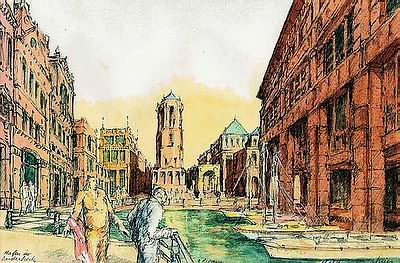
New Town of Ouderkerk, Holland (2002)
by Rob Krier (Krier&Kohl Architects, Berlin)
Should we assume that architects have been more intelligent,
skilled and talented in past times? Even if their outstanding achievements might suggest some "Golden Ages" of artistical
creations, we have no reason to think that nature begifted the past with larger portions of creative intelligence and artistical
talent!
Why then are the works of art, architecture and city-building comparably more successful, excellent and
universally admired than the immense production of mostly disappointing creations of recent decades? Are today's architects
and urbanists cut off from the means nature offers them so graciously, or are these means simply no longer accessible
to cultures which have set their own deconstruction as a purpose of art?
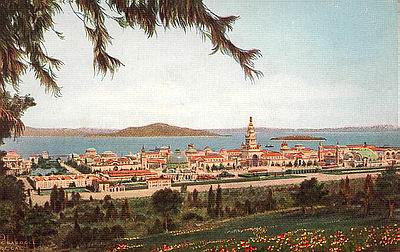
Panama Pacific International Exposition, San Franciso (1915)
by Bernard Maybeck (1862-1957)
(Picture by courtesy of Maybeck Foundation)
Now if there is one thing we might definitely assume,
it would be, that builders and architects of the past did not pretend, that their originality, creativity
and inventiveness were necessarily to be an ostentative renouncement to all the lessons of excellence, greatness and
humility, wisdom and perfection of historic cultures.
Even the famous "Querelle des Modernes et des
Anciens" happened within the conscious acknowledgement of Tradition as a primordial foundation of civilization! Wether
the ones believed the "Ancients" to be superior to the "Moderns" and the others the contrary, they all still conceived themselves
as "dwarfs on the shoulders of a giant", and their different conclusions remained a question of interpretation of Tradition
rather than of its rejection!
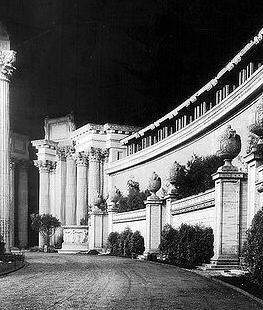
Peristyle Detail
by Bernard Maybeck
(Photo by Maybeck Foundation)
Whereas today, already in art and architectural schools,
students are challenged to invent and to experiment, --assuming all of them to be extraordinary and exceptional geniuses--,
beyond the limitations of knowledge, crafts and skills, and out of the realm of rules and responsibilities, the artists of
the past were challenged to be excellent within an expertise defined by time-tested principles, methods and rules encompassed
in a living tradition of arts and crafts....
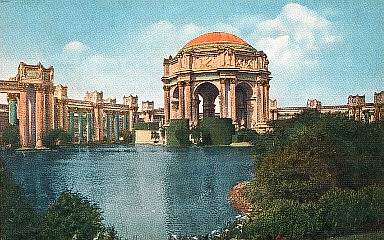
Palace of Fine Arts seen from Lagoon, San Francisco (1915)
(Only Remnant of the Panama Pacific International Exposition)
by Bernard Maybeck (1862-1957)
(Photo by courtesy of Maybeck Foundation)
Artists, architects and city-builders of past times, as
well a those contemporary ones which have resisted to follow a deluding mainstream modernism, they are original,
inventive and true in their works and their contributions to the contemporary culture of their time as much as to an universal
and timeless heritage of human genius!
They are so by the maturity of principles they adhere to and the freedom they develop from them in their
skills.
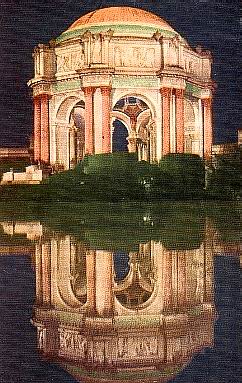
Dome of Fine Arts, San Francisco (1915)
by Bernard Maybeck
(Picture by courtesy of Maybeck Foundation)
Though artists like Michelangelo, Raphael and others were already
recognized and admired as geniuses during their lifetime, they never made their genius, --nor a purpose of their work,-- nor
a purpose of their life...
Rather then considering themselves as bearers of an individual genius, and their genius as their
personal gift to civilization, they acted more likely as the mediators of a genius of civilization the ideals and
potentials of which were entrusted upon them for the sake of its most outstanding fulfillment !
If they did ever break the rules (and they did not necessarily), it was within the very boundaries
defined by the principles of their art, and if ever they transgressed these boundaries, it was to establish new boundaries
of delight and excellence, and not for the sake of a private itineration into territories without rules and
boundaries!
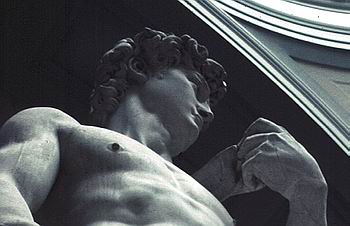
Detail of David, Piazza della Signoria, Florence
by Michelangelo (1475-1564)
(Photo by Mary Ann Sullivan)
|
